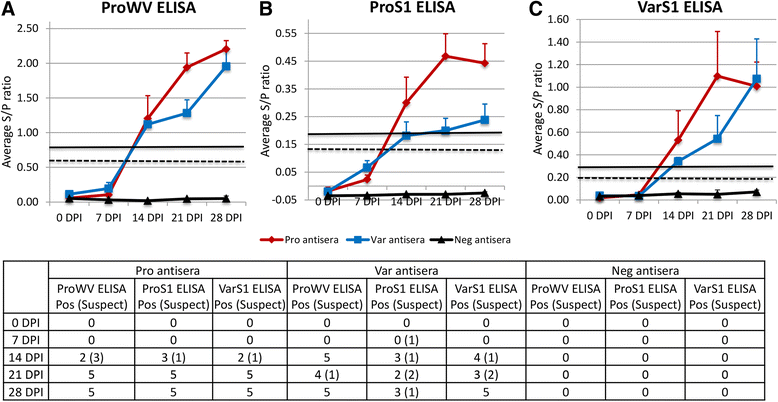Evaluation of serological cross-reactivity and cross-neutralization between the United States porcine epidemic diarrhea virus prototype and S-INDEL-variant strains
- PMID: 27044253
- PMCID: PMC4820917
- DOI: 10.1186/s12917-016-0697-5
Evaluation of serological cross-reactivity and cross-neutralization between the United States porcine epidemic diarrhea virus prototype and S-INDEL-variant strains
Abstract
Background: At least two genetically different porcine epidemic diarrhea virus (PEDV) strains have been identified in the United States (U.S. PEDV prototype and S-INDEL-variant strains). The current serological assays offered at veterinary diagnostic laboratories for detection of PEDV-specific antibody are based on the U.S. PEDV prototype strain. The objectives of this study were: 1) isolate the U.S. PEDV S-INDEL-variant strain in cell culture; 2) generate antisera against the U.S. PEDV prototype and S-INDEL-variant strains by experimentally infecting weaned pigs; 3) determine if the various PEDV serological assays could detect antibodies against the U.S. PEDV S-INDEL-variant strain and vice versa.
Results: A U.S. PEDV S-INDEL-variant strain was isolated in cell culture in this study. Three groups of PEDV-negative, 3-week-old pigs (five pigs per group) were inoculated orally with a U.S. PEDV prototype isolate (previously isolated in our lab), an S-INDEL-variant isolate or virus-negative culture medium. Serum samples collected at 0, 7, 14, 21 and 28 days post inoculation were evaluated by the following PEDV serological assays: 1) indirect fluorescent antibody (IFA) assays using the prototype and S-INDEL-variant strains as indicator viruses; 2) virus neutralization (VN) tests against the prototype and S-INDEL-variant viruses; 3) PEDV prototype strain whole virus based ELISA; 4) PEDV prototype strain S1-based ELISA; and 5) PEDV S-INDEL-variant strain S1-based ELISA. The positive antisera against the prototype strain reacted to and neutralized both prototype and S-INDEL-variant viruses, and the positive antisera against the S-INDEL-variant strain also reacted to and neutralized both prototype and S-INDEL-variant viruses, as examined by IFA antibody assays and VN tests. Antibodies against the two PEDV strains could be detected by all three ELISAs although detection rates varied to some degree.
Conclusions: These data indicate that the antibodies against U.S. PEDV prototype and S-INDEL-variant strains cross-reacted and cross-neutralized both strains in vitro. The current serological assays based on U.S. PEDV prototype strain can detect antibodies against both U.S. PEDV strains.
Keywords: ELISA; IFA; PEDV; Porcine epidemic diarrhea virus; Prototype; S-INDEL; Variant; Virus neutralization.
Figures



References
-
- Stevenson GW, Hoang H, Schwartz KJ, Burrough ER, Sun D, Madson D, Cooper VL, Pillatzki A, Gauger P, Schmitt BJ, et al. Emergence of Porcine epidemic diarrhea virus in the United States: clinical signs, lesions, and viral genomic sequences. J Vet Diagn Invest. 2013;25(5):649–654. doi: 10.1177/1040638713501675. - DOI - PubMed
-
- Pasick J, Berhane Y, Ojkic D, Maxie G, Embury-Hyatt C, Swekla K, Handel K, Fairles J, Alexandersen S. Investigation into the role of potentially contaminated feed as a source of the first-detected outbreaks of porcine epidemic diarrhea in Canada. Transbound Emerg Dis. 2014;61(5):397–410. doi: 10.1111/tbed.12269. - DOI - PMC - PubMed
-
- ICTV. International Committee on Taxonomy of Viruses. 2012. Virus Taxonomy: 2012 Release. 2012. http://ictvonline.org/virusTaxonomy.asp?version=2012. Accessed 2 Jan 2015.
Publication types
MeSH terms
Substances
LinkOut - more resources
Full Text Sources
Other Literature Sources
Miscellaneous

